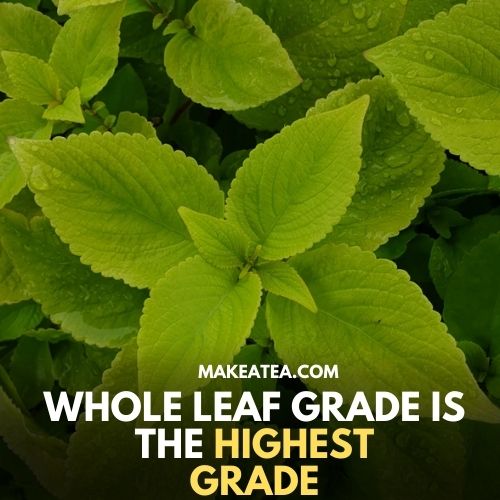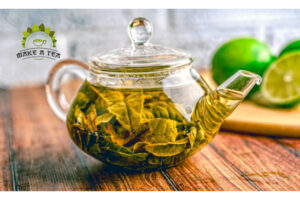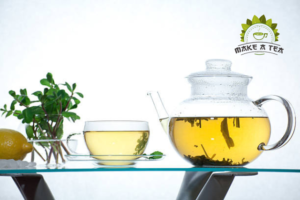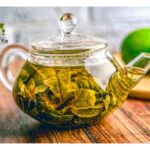Green tea grades may sound like a difficult term. The understanding of grading of tea & processing was a bit complicated.
But we’ve summarized it so that you can understand it easily.
Do you remember the grading system of your school?
It was completely based on your performance, quality of work, and results of the whole year.
Now, just Imagine the green tea grading the same way and try to understand all about green tea grades.
how and why it’s done and different types of grading observed around the world.
So, without any further delay let’s see what is it all about.
What Is Green Tea Grading?
We know that there are different types of green tea based on origin and processing. These differences between the types of tea leaves.
To determine the taste and highest quality teas, the grading system is followed in tea-producing countries. The condition and processing of tea leaves are tested.
There are four main types of leaves that are graded. Whole leaves, broken leaves, fanning, and dust.
Mostly the highest grades are whole leaf teas and the lowest being dust.
How & Why Is Grading Done?
There is no universal way of tea grading. Green tea grading is done by checking the green tea leaf’s origin, age, and wholeness.
The size and type of leaves used are checked in some methods while other methods use the end product when green tea leaves are done with the processing.
Tea Grading is done to determine the green tea leaves, which types are used in which brand.

In grading finest tp lowest quality are whole leaves to dust.
Therefore, green tea grading is a more personal system adopted by many regions around the world to grade their green tea leaves that produce dry green tea.
Each region has its ways and reasons to grade its tea.
Which Countries Follow the Grading System?
Each tea-producing county follows its grading systems. The most popular and old ones are Chinese and British ones followed in China and India.
Japanese, Korean, Sri Lanka, and Taiwan regions also follow the grading system,
Different Grades of Green Tea
While studying green tea grades of different areas, you will encounter the terms they use for their classifications. We described them easily for you to understand.
1) Size And Appearance Grades
The most easy way to grade the tea leaves is on the basis of size and shape. You can evaluate whole leaves this way. Chinese use the methods to grade the tea on its age, freshness and size.
2) Orange Pekoe
Orange Pekoe is a named that comes from Chinese origin. It means white hair and pronounced as PEK-HOE. It is the tip area of the tea.
This term is more common in India and Sri Lanka. Chinese do no use this term. Orange Pekoe means medium quality tea leaves that have a bud and a leaf both in them.
3) Whole Leaf Grades
This grade uses full green tea leaves with out damage. The sizes and shapes differ due to the types of green tea. These are the highest quality leaves.
[table id=67 /]

4) Broken Leaf Grades
You can recognize the tea leaves but they are not in full form. These are a little damaged and broken. Hence of second highest quality.
[table id=68 /]
5) Fanning
These are the fine pieces of damaged and broken leaves. Therefore, this type is mostly used in teabags.
[table id=69 /]
6) Dust
The fine powder left after the whole leaf and broken leaves are taken away is called dust. Most tea brands do not use this grade and therefore it’s sold in wholesale or teabags.
[table id=70 /]
Green Tea Grades In Different Regions
There is no international standard of grading teas. Each country has its types and grades. To differentiate we provide each one in detail for you.
1) Chinese Grading :-
Chinese grades use grading within the types of green tea. For example, Dragon well has its own grades. They categorize the quality and shapes of the tea leaves.
The youngest ones are considered the most fragile and hence are pure form of green tea and highest quality.
Most regular grades that are graded according to the age of the leaf and the finished shape and size in Chinese grading are as follows.
- Gunpowder
- Imperial
- Young Hyson
- Hyson
- Twankay
- Hyson Skin
- Dust
Sub-Grades
Pinhead Gunpowder
These varieties are rolled into leaves of gunpowder then categorized quality-wise.
- First
- Second
- Third
- Fourth
- Fifth
- Sixth
- Fancy
Reality
Chinese consider a lowered number of tea grades as low-quality tea. They categorize the tea in numbers.
The number 7to 9 is considered low there. In reality, the grade is not an indicator of the flavor of the tea. Although high-quality tea is stored and produced with care.
2) Japanese Grading :-
The grading method used in Japan is different. They grade the teas when they turn into final products. The size of leaves does not matter. The processing and storing have to be done correctly for better grading.

Japan Grades:
Japanese Grades from best to least are as follows.
- Gyokuro
- Sencha
- Tencha
- Bancha
- Kukicha
Reality
The lowest quality considered in Japan is Kukicha which is made of stems and twigs, not green tea leaves. This tea is given to the elderly and kids. The highest is Gyokuro which is a fine powder of green tea leaves.
As kukicha has medicinal value, this shows that grades depend more on reputation and cost in Japan than benefits and value.
3) Indian Grading :-
In Indian tea grading system was introduced by the British when they were ruling the subcontinent. The Orange Pekoe system is a commonly known tea grading system and followed in India.
Green tea is graded by the size of individual leaves and how wholesome are they.
Indian Grades:
India grades their tea similar to China by style and size of the leaf:
- Fine Young Hyson
- Young Hyson
- Hyson No. 1
- Hyson
- Soumee
- Fannings
- Dust
Reality
India is using one of the common and oldest methods set by the Britishers long ago called Orange Pekoe. Therefore the focus is more on broken and fine leaves. In India black is also has grades.
4) Taiwan Grading :-
The tea in Taiwan uses a more holistic approach. They grade according to preference and environment. Hence they grade their green tea from best to least this way.
Taiwanese Grades:
Choice
Fine
Superior
Good
Standard
Reality
Many private producers use and grade according to looks and demand. They categorize in 20% aroma, 20 % looks, and 60% flavor. Hence, this sounds like a realistic approach based more on consumer satisfaction.
What Is the Importance of Green Tea Grading?

The main origin of green tea is China. Many other tea-producing countries also started growing green tea like Taiwan and India.
- Firstly, to determine and keep the quality and competition different regions grade their teas for consumer satisfaction and keep the processing up to the mark.
- Indians makes green tea grades to main the standard of the green tea leaves.
- In addition, the taste and quality do not depend on the type and grade of tea. Many other factors count as well.
- Lastly, the grading tells us more about the green tea leaves used for making our loose-leaf or bagged tea.
Myths Around Green Tea Grades
Some myths floating around regarding the grading of teas. We will bust the myths for you.
Myth: Higher-Grade Tea Is Always Better Tea.
Answer: It is not necessary for high grade to be better in taste . Thus, this is a myth.
Myth: The most costly green tea are always high quality.
Answer: This is not true. Most costly green tea is not always high quality but how much harder is it to prepare. Therefore, it is a myth too.
Myth: Low Tea Grades Are Exported to Developing Countries.
Answer: You will find a high-quality grade in any developing county and a low grade in developed nations. Therefore, all grades are available and exported around the world.
Conclusion
Green tea grading is more about cultural preferences and types of green tea leaves used for the making of dry green tea. Hence, this does not represent any kind of quality and taste differences of teas.
Therefore, you can choose your tea simply based on the flavors you like and the best one that suits you.







